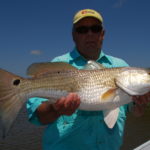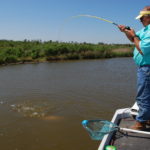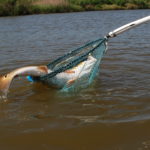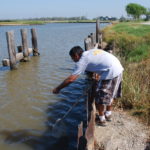
Redfishing just doesn’t come any easier than at Rockefeller Refuge this time of year.
I was stuffed and still the food came. I wondered if Gunner Waldmann and David Bertrand were trying to kill me. First, Waldmann forced me to participate in a redfish blowout that morning. Then he hauled me to Shucks Seafood House in Abbeville, where owner Bertrand took over.
First came Sassy Shrimp, then raw oysters, Char-Broiled Oysters, Oysters Rockefeller, Oysters Shuck-a-feller, Candied Oysters and Oysters Supreme. Bertrand snapped his fingers and Shrimp Remoulade appeared, followed by samplers of Seafood Gumbo and Smoked Duck and Andouille Gumbo.
Somewhere between the Crawfish Etouffee and the Crawfish Tamales my gastronomical senses became overwhelmed, and while Waldmann and Bertrand chatted like the 35-year friends that they are, my mind wandered back to the morning’s fishing adventure.
I didn’t meet Waldmann until 9 a.m. in Abbeville, and we still had a little over an hour’s drive to our fishing hole. It sure didn’t seem like we would have a lot of fishing time. But Waldmann seemed hyper-confident.
“We are headed to the Rock,” he informed me as soon as I settled in his truck. “We slaughtered the redfish here last week. We caught our limits and then caught and released them until we got tired. My only concern is that they will all be too big to keep.
“Rockefeller Wildlife Refuge opens to fishing on March 1 of each year, and I fish there a lot until the water gets hot. Then it gets good again in the fall when the water cools off.”
The 56-year-old Waldmann is a dedicated outdoorsman. From age 4 until 10, when he lost his father, they fished bass at night regularly on Avery Island, where the elder Waldmann worked. Then friends of his father and an uncle took him fishing, until he started fishing with a close group of friends in high school.
“I used to ‘troll’ for shrimp at lot,” he said. “Shrimp season always opened on a Monday, and I took off school every opening Monday. It was a rite of passage.”
Now he is a speckled trout, redfish and flounder specialist, although he occasionally wanders offshore for snapper and tuna. He also admits to a weakness for tripletail, which he fishes for south of Pecan Island.
“They will slap a Berkley GULP silly,” he averred.
It was after 10:30 a.m. before Waldmann launched his 18-foot custom-built aluminum boat at the southernmost of the two boat landings at East End Locks, what he called “Joseph’s Harbor.”
After launching, Waldmann piloted his boat eastward in the boundary canal on the northern edge of the refuge, then turned south into North Island Canal, which almost imperceptibly turned into Little Constance Bayou. First stop was Little Constance Bayou Control Structure, one of the concrete- and steel-gated structures that are used to regulate water levels within the refuge.
The day’s fishing would be concentrated between this structure and the Dyson Bayou Plug, although Waldmann admitted that he catches redfish and flounder in all the open canals and bayous in this vicinity.
When Waldmann killed the engine, instant peace descended around us. Not another motor or human noise was to be heard, something that was to last until we finished fishing. Rather, we were surrounded by bird calls and blizzards of flying fowl. Rockefeller is an avian extravaganza.
It’s also reptile world. During the run south, dozens and dozens of alligators slid from the banks as we approached. It was reminiscent of old Tarzan movies with their scenes of monstrous crocs (no doubt all man-eaters) slithering into the water.
As he rigged up, Waldmann gave me tackle instructions. He is very particular, confining himself to Owner jigheads, and only those with completely round heads.
“They shake loose from oyster reefs,” he explained. “Pointed heads don’t.”
No. 4 jigheads are his choice for fishing redfish. Color of the jighead he deems irrelevant.
He was very specific in his choice of lures as well — Berkley GULP and more Berkley GULP.
“Berkley GULP has made poor fishermen good, and has made good fishermen great,” he lectured with a straight face and a level gaze to make sure he was understood. “It’s the smell. The fish can smell it, and they hold on to it. It works on specks and reds, and flounder will kill it.”
His choices are almost exclusively swimming minnow, shrimp and grub, and his preferred color is glow, although he says that at certain times of the year he will use new penny. It didn’t take long before he grunted and sunk the hook home into an 18-incher. He was happy; on his last trip here, he and his partner had to sort through gobs of bull reds to find the 18- to 26-inch fish he prefers.
His technique was simple. As he maneuvered the trolling motor, he concentrated his casts in waters near the bank and the wooden bulkheads on each side of the control structures. His lures were fished tight-line, although he explained that at times he will fish them under a popping cork if the fish seem to prefer that presentation. His retrieve was a rhythmic bounce on the bottom — bump, bump, bump.
The redfish came pretty regularly after the first one, and Waldmann visibly relaxed.
“This is God’s country,” he audibly exhaled. “I feel at peace here. I can actually breathe — the smell of the water, the smell of the air. I like the scenery here in the spring. It has plenty of birds of all kinds and is one of the most sought-out birder locations in the world.”
Waldmann gave another reason for favoring Rockefeller Refuge for spring fishing. It is protected from the persistent winds of spring. He calls it “a maze of interconnected canals,” some of which are always fishable.
Waldmann noted that the refuge offers other activities besides fishing and birding.
“Crabbing is excellent,” he said. “You can get some jumbos, but so many people do it. Shrimping gets a lot of attention too. It really gets wild during shrimp season.”
With only a five-redfish per person limit, Waldmann quickly got picky, keeping only “perfect eating size” fish. Sixteen- and 17-inchers, as well as ones he judged to be “too big,” went back overboard one after the other.
And the gators! It was like Jurassic Park. Even Waldmann got impressed at one point. “Holy mackerel; Look at the lizards!”
Three or four would be visible on the surface of the water in any glance in any direction. Pairs and trios of the creatures took turns resting their noses against the sills of the water-control structures and snatching victims from the schools of mullets washing in with the tidal overflow.
It was impressive. It made one wonder how so many redfish could survive.
Quickly — in barely over an hour — even being picky, the redfish limit was reached and then it was catch-and-release fishing. Speckled trout are caught on the refuge later in the year, he explained, but not an option this early. But a perfect, platter-sized flounder was a welcome addition to the box and brought a huge grin to Waldmann’s face.
Even though he couldn’t keep any more redfish, the big German just didn’t want to quit fishing.
“I just love it here — I love it here,” he repeated. He socked the hook home on another one. “Oogh, that’s a nice fish. He’s got shoulders on him.”







